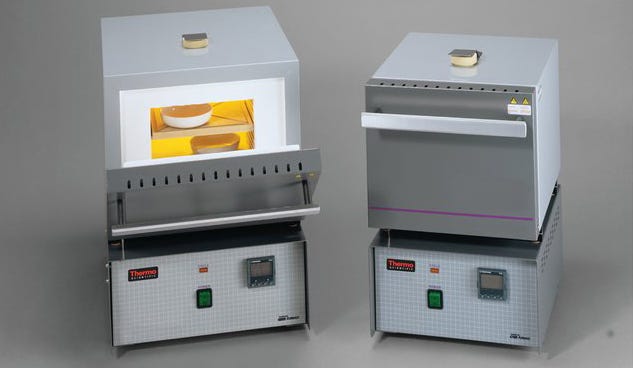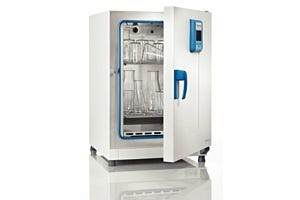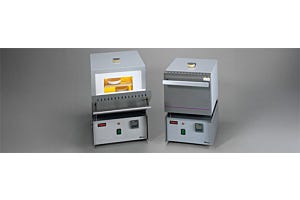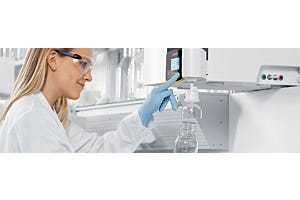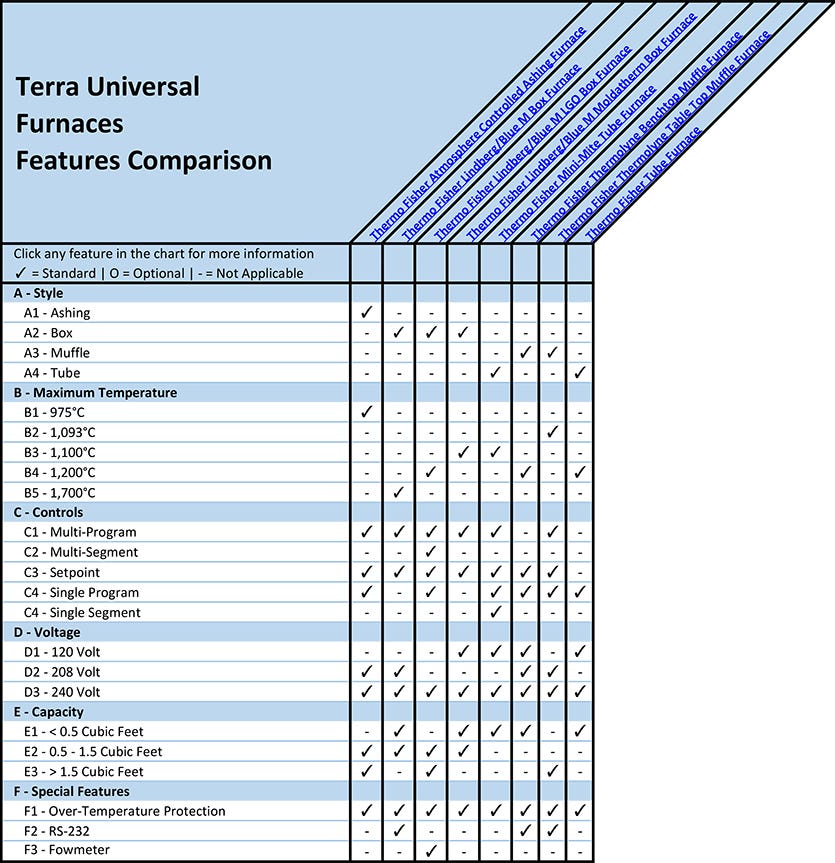
Laboratory furnaces are composed of a heating element connected to a sampling chamber and regulated by a digital controller.
What Is a Lab Furnace?
Lab furnaces perform several routine functions, including sample annealing, baking, curing, solvent removal and sterilization. Although most furnaces are designed for installation on a benchtop, specialty free-standing and walk-in furnaces are available.
How are Lab Furnaces Used?
Lab furnaces are commonly used in the material science, water treatment, environmental science, chemical, metal treatment, electronic, and agricultural biology industries.
Read More: Applications for Laboratory Ovens Across the Sciences
A - Furnace Style and Design
(back to chart)
A1 - Ashing Furnace
Ashing furnaces determine the change in weight of a compound as one or more constituents are burned off. Ashing furnaces are used for the material analysis of coal, rubber, plastics, and grain. Specialty porcelain quartz crucibles accommodate up to 38 samples for high-volume ashing or incineration.
A2 - Box Furnace
Box furnaces contain larger sample chambers than ashing and muffle furnaces for processing bulk samples, such as raw metals, plastics or electronics. Double-wall construction reduces exterior surface temperatures for operator protection and energy efficiency. Hinged side-mounted or top-mounted doors provide full-chamber access for quick loading and unloading of samples.
A3 - Muffle Furnace
Muffle furnaces are box furnaces equipped with ceramic fiber insulation to permit faster heating ramp rates than standard box furnaces. Muffle furnaces are used in laboratories for gravimetric analysis, sintering of small organics, quantitative analysis, and sample volatility studies.
Read More: Box, Muffle & Tube Laboratory Furnaces
A4 - Tube Furnace Design
Tube furnaces are designed for heating small samples in an inert atmosphere. Certain models include three-zone controls to support segmentation of the sampling chamber into three distinct temperature gradients for material testing. Tube furnaces are used for sample viscosity testing, calibration, thermal expansion, and crystal growing.
B - Maximum Lab Furnace Temperature
(back to chart)
Laboratory furnaces include a PLC controller to regulate temperatures from 100°C to the maximum temperature of the furnace, which ranges between 975°C and 1,700°C. Although lab ovens are also used for sample annealing, curing and baking, standard ovens do not maintain temperatures above 350°C.
C - Lab Furnace Controls and Programs
(back to chart)
Thermo Fisher Scientific lab furnaces include integral PLC controllers mounted on the front panel of the unit for easy access and maintenance. Integral controllers provide several layers of method and programming control to support simple and advanced protocols.
C1 - Multi-Program Furnace
Thermo Fisher’s Lindberg/Blue M Box Furnaces include controllers capable of storing up to 25 different programs, each with multiple segments.
C2 - Multi-Segment Furnace
Multi-segment furnace controllers allow for the segmentation of each program into individual ramp times (heating or cooling) and dwell times. Program patterns are defined by either time or rate and programs are repeatable for 999 cycles.
C3 - Furnace Setpoint
Simplified setpoint furnace controllers support protocols calling for a single-segment ramp to a specified temperature.
C4 - Single Program Furnace Controllers
Thermo Fisher Tube Furnaces with economical single program controllers, do not include a database of saved programs for quick retrieval. The single program, however, accommodates multiple segments for advanced heating protocols.
C5 - Single Segment Furnace Controllers
Single segment furnace controllers support procedures defining a single-segment ramp to a specified temperature, but may support multiple saved programs for different sample types.
D - Furnace Voltage
(back to chart)
120-volt connections are suitable for standard laboratory power outlets in the United States.
208-volt or 240-volt connections require less current (amperage) and smaller conductors than equipment designed to operate at 120-volt.
E - Furnace Capacity
(back to chart)
Standard lab furnaces, given their double-wall design and thermal insulation, contain smaller sampling chambers than laboratory ovens.
Common lab furnace capacities vary from 0.2 cubic feet to 2.5 cubic feet in size.
Browse By Furnace Size
F - Special Furnace Features
(back to chart)
F1 - Over-Temperature Protection
Digital, adjustable over-temperature control protects the furnace and electrical load in the event of controller failure by shutting off power once the setpoint is reached.
F2 - RS-232 Furnace
Thermo Fisher Thermolyne Benchtop Muffle Furnaces include RS-232 ports for two-way communication between the furnace and a printer or remote computer.
F3 - Furnace Flowmeter
Thermo Fisher Lindberg/Blue M LGO Box Furnaces include an adjustable gas flowmeter, mounted on the front panel for purging the sampling chamber with an inert gas, such as Nitrogen or Argon.
Find a Laboratory Furnace Manufacturer
Laboratory-Equipment.com is a specialty division of Terra Universal. For nearly 40 years, Terra Universal has served the life science, pharmaceutical, biotechnology, and medical device markets. Customers appreciate a worldwide network of reps, factory-direct support, and ready-to-ship items available from Terra's manufacturing and warehouse facilities in Fullerton, California.
Shop laboratory furnaces online for a wide variety of food, pharmaceutical, laboratory, and analytical environments.
Thermo Fisher Lindberg/Blue M LGO
U.S. Customer Service
Email: [email protected]
Phone: (714) 578-6016
Contact a Laboratory-equipment.com specialist through web chat, email, or phone for pricing or a same-day quote.



